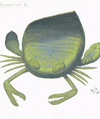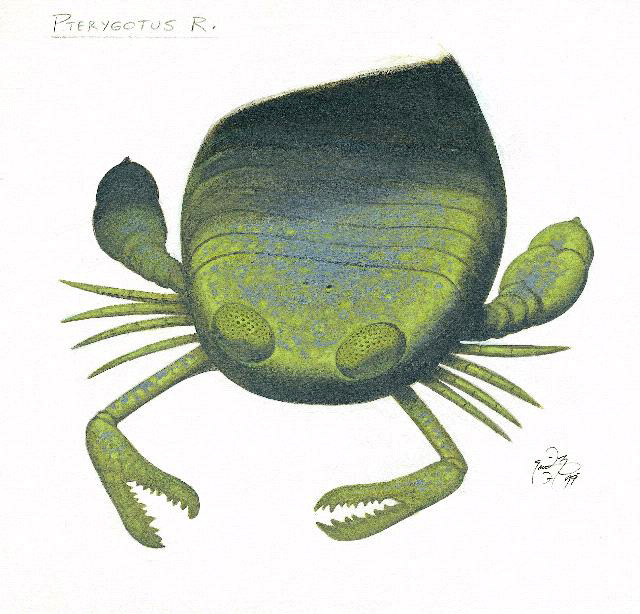Pterygotus
Giant monsters lurked in Devonian waters! And it wasn’t just vertebrates that reached enormous sizes: huge arthropod invertebrates roamed the waters as well.
 (64 kb) Imagine giant water scorpions more than two metres long!
(64 kb) Imagine giant water scorpions more than two metres long!
Water scorpions are officially known as eurypterids, which were fairly common throughout most of the Paleozoic and typically measured less than 20 cm long. Some species, however, reached enormous sizes. Although shapes varied from species to species, all eurypterids had a wide head with large eyes and six pairs of jointed appendages. The first pair, called chelicerae, was specially adapted for capturing prey and grinding food. The next four pairs served as legs to walk along the bottom, and the last pair, which looked like paddles, enabled them to swim.
The rear of the body was divided into several sections that terminated in a tapered tail called the telson. Eurypterids somewhat resembled the land-dwelling scorpions of today, and in some ways, horseshoe crabs as well.
The sediments of the Escuminac Formation have yielded some rare eurypterid fragments. The best preserved are pieces of the sixth pair of appendages, the ones that may have been used for swimming. They display a strong resemblance to the genus Pterygotus, the largest of all the eurypterids, which surpassed two metres. In fact, Pterygotus was the largest arthropod of all time.
At Miguasha, the rarity of eurypterid fossils, their fragmented appearance, and the fact that we find them with broken plant debris, leads us to believe that they were transported some distance from the banks before being covered by sediments.
Eurypterids preferred the brackish water of deltas, estuaries and coasts, with some members restricted to purely marine environments. A one- metre-long eurypterid found in the northern Baie de Gaspé left traces in sandy mud as it walked through very shallow water during Lower Devonian time. In Scotland, tracks left by a large eurypterid, 1.6 metres long by one metre wide, demonstrate that it walked on land at the beginning of the Carboniferous. The evidence for this is that its tail left a central trace between the prints, and therefore could not have been supported by water. If these animals were capable of surviving a short while on land, it could be an argument in favour of an eurypterid ancestry for scorpions, but most researchers believe their superficial resemblance is only the result of convergent evolution.

 (64 kb) Imagine giant water scorpions more than two metres long!
(64 kb) Imagine giant water scorpions more than two metres long!Water scorpions are officially known as eurypterids, which were fairly common throughout most of the Paleozoic and typically measured less than 20 cm long. Some species, however, reached enormous sizes. Although shapes varied from species to species, all eurypterids had a wide head with large eyes and six pairs of jointed appendages. The first pair, called chelicerae, was specially adapted for capturing prey and grinding food. The next four pairs served as legs to walk along the bottom, and the last pair, which looked like paddles, enabled them to swim.
The rear of the body was divided into several sections that terminated in a tapered tail called the telson. Eurypterids somewhat resembled the land-dwelling scorpions of today, and in some ways, horseshoe crabs as well.
The sediments of the Escuminac Formation have yielded some rare eurypterid fragments. The best preserved are pieces of the sixth pair of appendages, the ones that may have been used for swimming. They display a strong resemblance to the genus Pterygotus, the largest of all the eurypterids, which surpassed two metres. In fact, Pterygotus was the largest arthropod of all time.
At Miguasha, the rarity of eurypterid fossils, their fragmented appearance, and the fact that we find them with broken plant debris, leads us to believe that they were transported some distance from the banks before being covered by sediments.
Eurypterids preferred the brackish water of deltas, estuaries and coasts, with some members restricted to purely marine environments. A one- metre-long eurypterid found in the northern Baie de Gaspé left traces in sandy mud as it walked through very shallow water during Lower Devonian time. In Scotland, tracks left by a large eurypterid, 1.6 metres long by one metre wide, demonstrate that it walked on land at the beginning of the Carboniferous. The evidence for this is that its tail left a central trace between the prints, and therefore could not have been supported by water. If these animals were capable of surviving a short while on land, it could be an argument in favour of an eurypterid ancestry for scorpions, but most researchers believe their superficial resemblance is only the result of convergent evolution.
Site map | Feedback | Links | Sources | Credits
Pterygotus
<< Asmusia | Segmented worms >>



